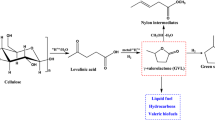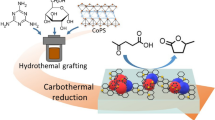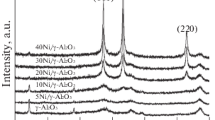Abstract
In the process of converting biomass into high value-added chemicals, transfer hydrogenation as a mild hydrogenation method has attracted more and more attention. The catalysts with hydrogenation sites (nano CuNi alloy) and acid sites (Al oxide) highly dispersed on the surface of a stable support (active carbon) were prepared and the importance of acid sites for the activity of CuNi catalysts in transfer hydrogenation was demonstrated. The catalysts showed promising catalytic activity on the transfer hydrogenation of levulinic acid (LA) to γ-valerolactone (GVL). The CuNi-1Al/AC with 5 wt.% CuNi alloy and 5 wt.% Al got 97.2% GVL yield and 100% LA conversion at 220 ℃ in isopropanol for 2 h. The high activity of the catalyst is attributed to the promoted esterification by the supported acid sites. The Al-modified catalyst also showed activity for esterification reaction in different alcohol hydrogen donors. The catalyst occurs inactive during the cycle due to the shedding of the active components, and the stability of catalyst is effectively improved by a stepwise impregnation.
Graphical abstract














Similar content being viewed by others
References
Horváth I, Mehdi H, Fábos V et al (2008) Gamma-valerolactone-a sustainable liquid for energy and carbon-based chemicals. Green Chem 10(2):238–242
Bond JQ, Alonso DM, Wang D et al (2010) Integrated catalytic conversion of gamma-valerolactone to liquid alkenes for transportation fuels. Science 327(12):1110–1113
Duan ZQ, Hu F (2012) Highly efficient synthesis of phosphatidylserine in the eco-friendly solvent γ-valerolactone. Green Chem 14(6):1581–1583
Bruno TJ, Wolk A, Naydich A (2010) Composition-explicit distillation curves for mixtures of gasoline and diesel fuel with γ-valerolactone. Energy Fuels 24(4):2758–2767
Wettstein SG, Alonso DM, Chong YX et al (2012) Production of levulinic acid and gamma-valerolactone (GVL) from cellulose using GVL as a solvent in biphasic systems. Energy Environ Sci 5(8):8199–8203
Bozell JJ, Petersen GR (2010) Technology development for the production of biobased products from biorefinery carbohydrates-the US Department of Energy’s “Top 10” revisited. Green Chem 12(4):539–554
Wright WR, Palkovits R (2012) Development of heterogeneous catalysts for the conversion of levulinic acid to gamma-valerolactone. Chemsuschem 5(9):1657–1667
Tang X, Zeng XH, Li Z et al (2014) Production of γ-valerolactone from lignocellulosic biomass for sustainable fuels and chemicals supply. Renew Sustain Energy Rev 40:608–620
Abdelrahman OA, Heyden A, Bond JQ (2014) Analysis of kinetics and reaction pathways in the aqueous-phase hydrogenation of levulinic acid to form γ-valerolactone over Ru/C. ACS Catal 4(4):1171–1181
Rojas-Buzo S, Garcia-Garcia P, Corma A (2018) Catalytic transfer hydrogenation of biomass-derived carbonyls over hafnium-based metal-organic frameworks. Chemsuschem 11(2):432–438
Wang HJ, Chen C, Zhang HM et al (2018) An efficient and reusable bimetallic Ni3Fe NPs@C catalyst for selective hydrogenation of biomass-derived levulinic acid to gamma-valerolactone. Chin J Catal 39(10):1599–1607
Kuwahara Y, Kaburagi W, Osada Y et al (2017) Catalytic transfer hydrogenation of biomass-derived levulinic acid and its esters to γ-valerolactone over ZrO2 catalyst supported on SBA-15 silica. Catal Today 281(1):418–428
Hengnea AM, Kadub BS, Biradara NS et al (2016) Transfer hydrogenation of biomass-derived levulinic acid to gamma-valerolactone over supported Ni catalysts. RSC Adv 6(64):59753–59761
Dutta S, Yu IKM, Tsang DCW et al (2019) Green synthesis of gamma-valerolactone (GVL) through hydrogenation of biomass-derived levulinic acid using non-noble metal catalysts: a critical review. Chem Eng J 372(15):992–1006
Obregon I, Gandarias I, Al-Shaal MG et al (2016) The role of the hydrogen source on the selective production of gamma-valerolactone and 2-methyltetrahydrofuran from levulinic acid. Chemsuschem 9(17):2488–2495
Gupta SSR, Kantam ML (2018) Selective hydrogenation of levulinic acid into γ-valerolactone over Cu/Ni hydrotalcite-derived catalyst. Catal Today 309(1):189–194
Wang M, Wang L, Li H et al (2015) Ratio-controlled synthesis of CuNi octahedra and nanocubes with enhanced catalytic activity. J Am Chem Soc 137(44):14027–14030
Pendem S, Mondal I, Shrotri A et al (2018) Unraveling the structural properties and reactivity trends of Cu-Ni bimetallic nanoalloy catalysts for biomass-derived levulinic acid hydrogenation. Sustain Energy Fuels 2(7):1516–1529
Obregón I, Corro E, Izquierdo U et al (2014) Levulinic acid hydrogenolysis on Al2O3-based Ni-Cu bimetallic catalysts. Chin J Catal 35(5):656–662
Ye FY, Zhang DM, Xue T et al (2014) Enhanced hydrogenation of ethyl levulinate by Pd-AC doped with Nb2O5. Green Chem 16(8):3951–3957
Moreno-Marrodan C, Barbaro P (2014) Energy efficient continuous production of γ-valerolactone by bifunctional metal/acid catalysis in one pot. Green Chem 16(7):3434–3438
Wang S, Eberhardt TL, Pan H (2022) Efficient dehydration of fructose into 5-HMF using a weakly-acidic catalyst prepared from a lignin-derived mesoporous carbon. Fuel 316(15):123255
Wang S, Eberhardt TL, Guo DY et al (2022) Efficient conversion of glucose into 5-HMF catalyzed by lignin-derived mesoporous carbon solid acid in a biphasic system. Renewable Energy 190:1–10
Yao YR, Wang ZQ, Zhao S et al (2014) A stable and effective Ru/polyethersulfone catalyst for levulinic acid hydrogenation to γ-valerolactone in aqueous solution. Catal Today 234(1):245–250
Kumar VV, Naresh G, Sudhakar M et al (2016) An investigation on the influence of support type for Ni catalysed vapour phase hydrogenation of aqueous levulinic acid to γ-valerolactone. RSC Adv 6(12):9872–9879
Shao YW, Sun K, Li QY et al (2019) Copper-based catalysts with tunable acidic and basic sites for the selective conversion of levulinic acid/ester to gamma-valerolactone or 1,4-pentanediol. Green Chem 21(16):4499–4511
Yu Z, Lu X, Bai H et al (2020) Effects of solid acid supports on the bifunctional catalysis of levulinic acid to gamma-valerolactone: catalytic activity and stability. Chemistry-an Asian Journal 15(8):1182–1201
Mohan V, Venkateshwarlu V, Pramod CV et al (2014) Vapour phase hydrocyclisation of levulinic acid to gamma-valerolactone over supported Ni catalysts. Catal Sci Technol 4(5):1253–1259
Putrakumar B, Nagaraju N, Kumar VP et al (2015) Hydrogenation of levulinic acid to gamma-valerolactone over copper catalysts supported on γ-Al2O3. Catal Today 250(15):209–217
Kumar VV, Naresh G, Sudhakar M et al (2015) Role of Brønsted and Lewis acid sites on Ni/TiO2 catalyst for vapour phase hydrogenation of levulinic acid: kinetic and mechanistic study. Appl Catal A 505(25):217–223
Sakakibara K, Endo K, Osawa T (2019) Facile synthesis of γ-valerolactone by transfer hydrogenation of methyl levulinate and levulinic acid over Ni/ZrO2. Catal Commun 125(10):52–55
Xie ZB, Chen BF, Wu HR et al (2019) Highly efficient hydrogenation of levulinic acid into 2-methyltetrahydrofuran over Ni-Cu/Al2O3-ZrO2 bifunctional catalysts. Green Chem 21(3):606–613
Luo W, Deka U, Beale AM et al (2013) Ruthenium-catalyzed hydrogenation of levulinic acid: influence of the support and solvent on catalyst selectivity and stability. J Catal 301:175–186
Zhou WW, Yang L, Liu L et al (2020) Synthesis of novel NiMo catalysts supported on highly ordered TiO2-Al2O3 composites and their superior catalytic performance for 4, 6-dimethyldibenzothiophene hydrodesulfurization. Appl Catal B 268(5):118428
Xu Q, Li XL, Pan T et al (2016) Supported copper catalysts for highly efficient hydrogenation of biomass-derived levulinic acid and γ-valerolactone. Green Chem 18(5):1287–1294
Li ZX, Wei XY, Liu GH et al (2020) Highly selective hydrogenation of furfural and levulinic acid over Ni0.09Zn/NC600 derived from ZIFW-8. Molecular Catalysis 480:110651
Liu LJ, Lou H, Chen M (2016) Selective hydrogenation of furfural to tetrahydrofurfuryl alcohol over Ni/CNTs and bimetallic Cu-Ni/CNTs catalysts. Int J Hydrogen Energy 41(33):14721–14731
Liu DW, Zhang LN, Han WP et al (2019) One-step fabrication of Ni-embedded hierarchically-porous carbon microspheres for levulinic acid hydrogenation. Chem Eng J 369(1):386–393
Xu H, Hu D, Yi ZX et al (2019) Solvent tuning the selective hydrogenation of levulinic acid into biofuels over Ni-metal organic framework-derived catalyst. ACS Appl Energy Mater 2(10):6979–6983
Jori PK, Jadhav VH (2020) Efficient synthesis of γ-valerolactone: a potential fuel from biomass derived levulinic acid using catalytic transfer hydrogenation over Hf@CCSO3H catalyst. Catal Lett 150(7):2038–2044
Huang RL, Liu Y, Zhang JH et al (2021) Catalytic transfer hydrogenation of levulinic acid to γ-valerolactone over an acids-base trifunctional Hf-bagasse coordination complex derived catalyst. Fuel 305(1):121557
Yoshida R, Sun DL, Yamada Y et al (2018) Stable Cu-Ni/SiO2 catalysts prepared by using citric acid-assisted impregnation for vapor-phase hydrogenation of levulinic acid. Molecular Catalysis 454:70–76
Berthomé G, N’Dah E, Wouters Y et al (2005) Temperature dependence of metastable alumina formation during thermal oxidation of FeCrAl foils. Mater Corros 56(6):389–392
Johnson JA, Makis JJ, Marvin KA et al (2013) Size-dependent hydrogenation of p-nitrophenol with Pd nanoparticles synthesized with poly(amido)amine dendrimer templates. J Phys Chem C 117(44):22644–22651
Primo A, Concepcion P, Corma A (2011) Synergy between the metal nanoparticles and the support for the hydrogenation of functionalized carboxylic acids to diols on Ru/TiO2. Chem Commun 47(12):3613–3615
Bhogeswararao S, Srinivas D (2015) Catalytic conversion of furfural to industrial chemicals over supported Pt and Pd catalysts. J Catal 327:65–77
Hengst K, Ligthart DAJM, Doronkin DE et al (2017) Continuous synthesis of gamma-valerolactone in a trickle-bed reactor over supported nickel catalysts. Ind Eng Chem Res 56(10):2680–2689
Cai B, Zhang YJ, Feng JF et al (2021) Highly efficient g-C3N4 supported ruthenium catalysts for the catalytic transfer hydrogenation of levulinic acid to liquid fuel γ-valerolactone. Renewable Energy 177:652–662
Gundeboina R, Gadasandula S, Velisoju VK et al (2019) Ni-Al-Ti hydrotalcite based catalyst for the selective hydrogenation of biomass-derived levulinic acid to gamma-valerolactone. Chemistry Select 4(1):202–210
Wang YJ, Cipolletta M, Vernières-Hassimi L et al (2019) Application of the concept of linear free energy relationships to the hydrogenation of levulinic acid and its corresponding esters. Chem Eng J 374(15):822–831
Enumula SS, Gurram VRB, Kondeboina M et al (2016) ZrO2/SBA-15 as an efficient catalyst for the production of gamma-valerolactone from biomass-derived levulinic acid in the vapour phase at atmospheric pressure. RSC Adv 6(24):20230–20239
Cai B, Zhou XC, Miao YC et al (2017) Enhanced catalytic transfer hydrogenation of ethyl levulinate to γ-valerolactone over a robust Cu-Ni bimetallic catalyst. ACS Sustain Chem Eng 5(2):1322–1331
Acknowledgements
We would like to thank the School of Chemical Engineering and the Institute of New Energy and Low-Carbon Technology of Sichuan University for providing the characterization of XRD, SEM, and BET.
Funding
This work was supported by the Program of National Natural Science Foundation of China (No. 21808148), Lishui Key Research Project (2021ZDYF01), the Cooperation Fund of Sichuan University and The People’s Government of Yibin City (No. 2020CDYB-34), and Sichuan Science and Technology Program (2020YFG0314).
Author information
Authors and Affiliations
Contributions
Nanxi Yu: writing the manuscript. Wei Yang: involved in the preparation of the catalyst. Yuxin Zheng: involved in the preparation of the catalyst. Kejing Wu: have characterized some of the data. Qiang Hu: provided partial revision of the manuscript. Yingying Liu: have characterized some of the data. Houfang Lu: provided critical revision of the manuscript. Bin Liang: provided critical revision of the manuscript.
Corresponding author
Ethics declarations
Conflict of interest
The authors declare no competing interests.
Additional information
Publisher's Note
Springer Nature remains neutral with regard to jurisdictional claims in published maps and institutional affiliations.
Supplementary Information
Below is the link to the electronic supplementary material.
Rights and permissions
About this article
Cite this article
Yu, N., Lu, H., Yang, W. et al. Transfer hydrogenation of levulinic acid to γ-valerolactone over acid site-modified CuNi alloy. Biomass Conv. Bioref. 14, 8271–8282 (2024). https://doi.org/10.1007/s13399-022-02887-2
Received:
Revised:
Accepted:
Published:
Issue Date:
DOI: https://doi.org/10.1007/s13399-022-02887-2




